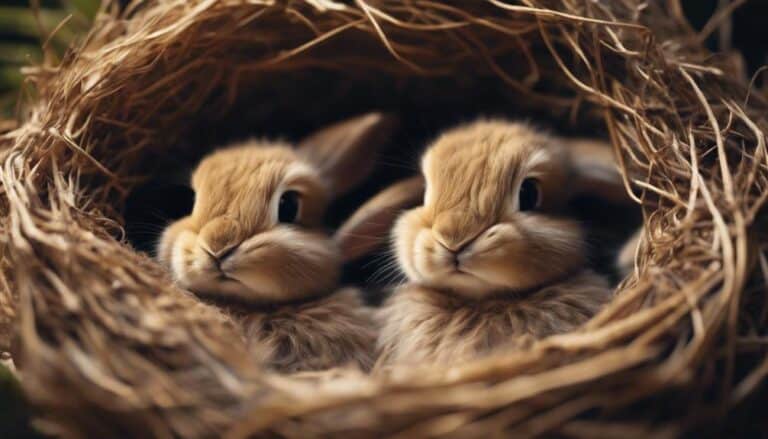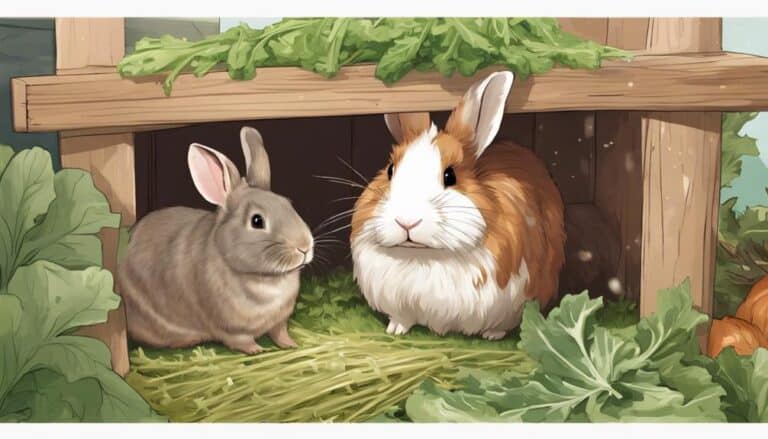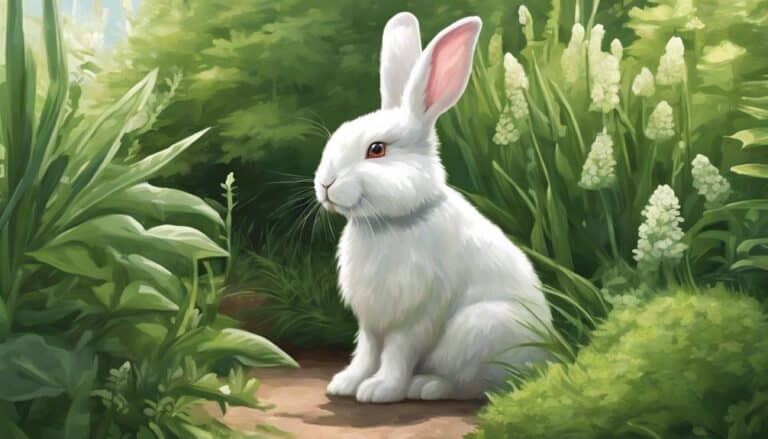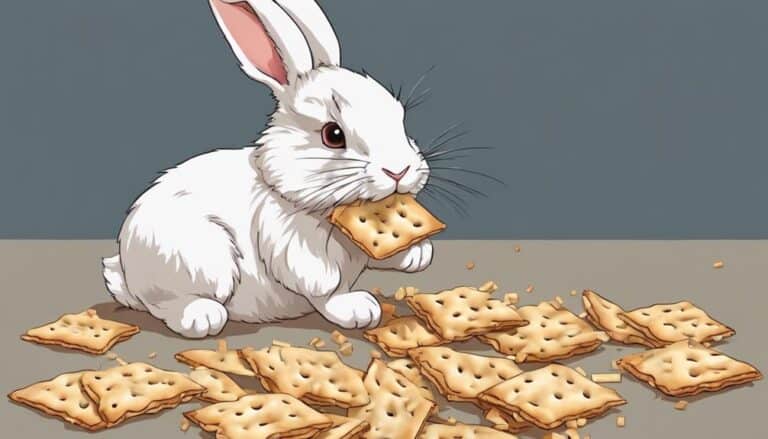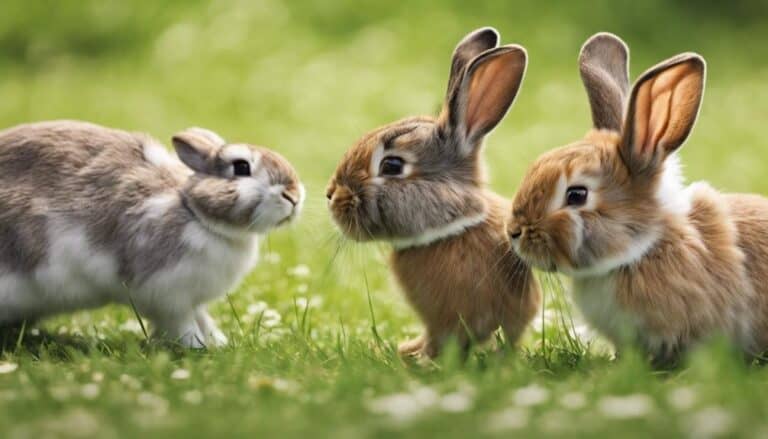Bunnies have eyes positioned high on their heads, giving them a wide 360-degree view to spot any potential threats. They can switch between using one eye and both eyes together, although their color vision is limited and focuses more on movement and brightness.
With a lot of rod cells in their eyes, they are great at seeing in low-light conditions, which is why they are most active during dawn and dusk. Their wide-angle vision is handy for detecting predators, and the placement of their eyes helps them see above and around themselves.
These eye features enhance their awareness and ability to spot danger. Knowing about their vision can help you set up the perfect living space for your bunny.
Contents
- 1 Key Takeaways
- 2 Bunny's Unique Eye Positioning
- 3 Bunny's Color Vision Abilities
- 4 Bunny's Adaptation to Low-Light Environments
- 5 Bunny's Wide Field of View
- 6 Bunny's Predator Detection Skills
- 7 Bunny's Visual and Auditory Coordination
- 8 Bunny's Visual Care and Habitat Considerations
- 9 Frequently Asked Questions
- 10 Conclusion
Key Takeaways
Rabbits have wide-angle vision, which helps them spot dangers like predators sneaking up on them. They mainly see blues and greens because of their dichromatic vision, meaning they see in two main colors. This color scheme helps them blend in with their surroundings and stay camouflaged.
Additionally, rabbits have more rod cells in their eyes, which enhance their ability to see in low-light conditions. This comes in handy during dawn and dusk when predators are most active. Their eyes are also positioned on the sides of their head, giving them a wider field of view to spot any threats approaching from different angles.
Another cool thing about rabbits is that they can switch between monocular and binocular vision. This means they can focus on something with both eyes (binocular) for better depth perception, or they can use each eye separately (monocular) to keep an eye on their surroundings. It's like having a built-in security system that helps them stay alert and aware of their environment.
Bunny's Unique Eye Positioning
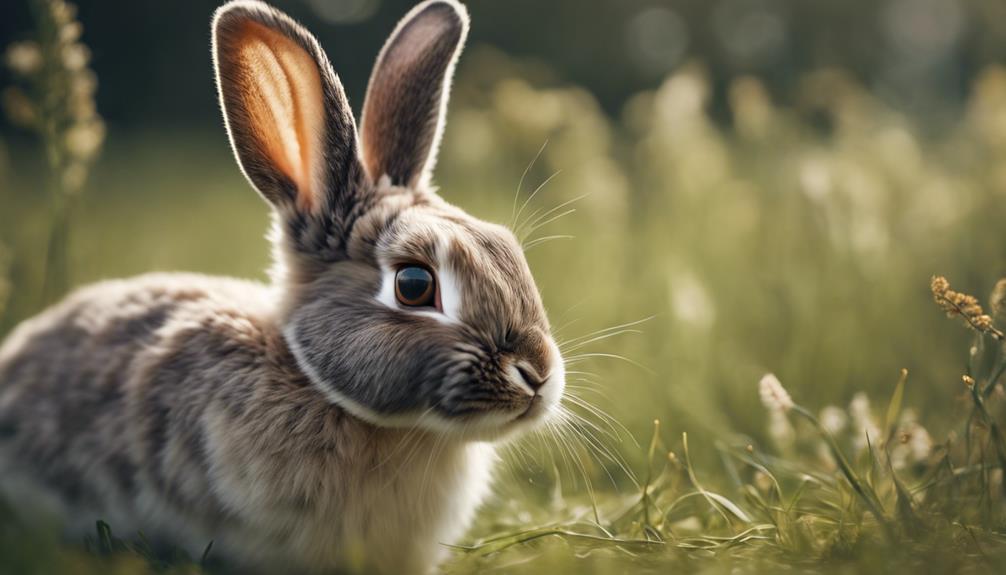
Rabbits have a cool eye setup – their eyes are located high on the sides of their heads, giving them a wide 360-degree view. This means they can see all around them, unlike us humans who mainly see straight ahead. With this setup, rabbits can spot dangers from different directions, like predators sneaking up from above or the sides. But, there's a catch – they've a small blind spot right in front of their faces, which can make it tricky for them to see things up close.
Even though they've this blind spot, rabbits are pretty smart. They can quickly switch between using each eye separately (monocular vision) and using both eyes together (binocular vision). This helps them scan their surroundings effectively, keeping an eye out for any potential threats. It's like they've the best of both worlds – being able to focus on details up close and keep an eye on the bigger picture at the same time.
Bunny's Color Vision Abilities
When you check out how bunnies see colors, it's good to know that they can only see a few colors. They mainly see blues and greens, and they can't see red or yellow like we can. This is because bunnies have dichromatic vision, which means they've two color receptors instead of three like humans.
Because of their limited color vision, bunnies focus more on movement and brightness in their surroundings. This helps them spot potential dangers and find food more easily. It's a cool adaptation that suits their needs for survival.
Colors Bunnies Recognize
Bunnies see the world in blue and green tones, but they can't pick out red or yellow colors. Basically, they're color blind to certain hues, unlike us humans. But don't worry, they make up for it by paying extra attention to brightness and movement.
This helps them spot predators and move around without any issues. If you want to keep a bunny happy, it's important to set up their space with their limited color vision in mind. Creating an environment that suits their visual abilities can really improve their well-being and quality of life.
Visual Spectrum Perception
Rabbits have a limited range of cone cells in their retinas, so they see the world in blue and green shades but can't really tell red or yellow colors apart. This means their color vision isn't as good as ours. However, bunnies are great at seeing in low-light situations because they've more rod cells than cones, which helps them see better at night. They focus more on movement and brightness rather than specific colors, which helps them spot predators and find their way around easily.
Understanding how rabbits see colors is important for making sure their surroundings and interactions take their unique vision into account. This way, we can create environments that suit them well and make them feel comfortable in different situations.
Adaptation to Light
Rabbits can see blue and green colors because of how their eyes work. They don't see red or yellow as well as humans do, so they're a bit color blind in comparison. But, they're really good at seeing in low light. This is because they've more rod cells than cone cells in their eyes.
Rabbits are most active during dawn and dusk, which is called crepuscular activity. In dim light, they mightn't see things clearly up close. But, they make up for it with their strong sense of smell. Knowing how rabbits see colors and how well they adjust to different light levels helps us create environments that suit them. We can adapt our interactions with rabbits based on their vision, making sure they do well in all kinds of lighting.
Bunny's Adaptation to Low-Light Environments
Rabbits have a cool trick when it comes to seeing in the dark. They've got more rod cells than cone cells in their eyes, which helps them see better in low light.
Rod cells are all about picking up light and movement, but they're not so great at telling colors apart like cone cells do.
This setup gives rabbits an edge in dim lighting situations, like at sunrise and sunset when they're most active.
Bunny's Wide Field of View
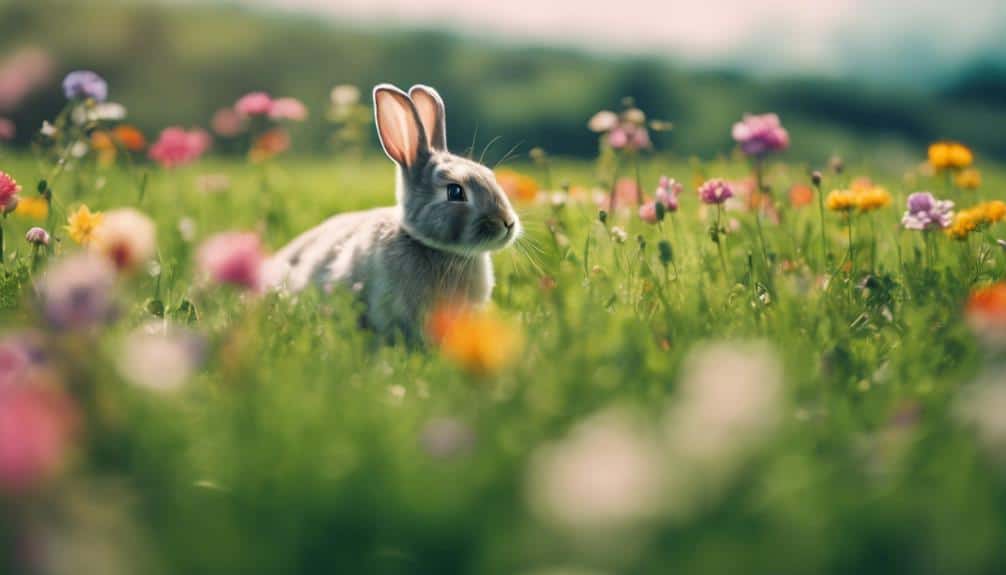
Bunnies have big eyes on the sides of their heads, giving them a really wide field of view. This helps them see possible dangers from all different directions, like if a predator is sneaking up on them.
With their wide-angle vision, bunnies can keep a close watch on what's going on around them and stay alert for any signs of trouble. It's like they've built-in survival skills to stay safe in the wild.
Wide-Angle Vision
Bunnies have big eyes on the sides of their heads, giving them a wide-angle vision that helps them spot potential dangers all around. This special vision lets them keep an eye on their surroundings and react fast to any threats.
Bunnies are really good at noticing movements above and around them, which is super useful for their survival instincts. Their wide field of view is important for seeing predators coming from different directions, keeping them on high alert and out of harm's way.
Surroundings Awareness
Bunnies have amazing eyesight! Their eyes are positioned on the sides of their head, giving them a super wide view of everything around them. This helps them spot any potential dangers or predators quickly and from all directions. With a 360-degree field of vision, bunnies can keep an eye on different areas all at once. Plus, this wide view also helps them see things far away, so they can detect threats early on.
What's really cool is that bunnies can switch between using one eye or both eyes to see. This gives them a double advantage when it comes to spotting danger and being aware of what's going on around them. Their sharp awareness of their surroundings is a key survival skill that helps bunnies stay alert and safe in their environment.
Bunny's Predator Detection Skills
Ever noticed how bunnies have their eyes placed high on the sides of their heads? It's not just a random design – it actually helps them spot predators from different angles. This eye setup gives rabbits a wide field of vision, making it easier for them to detect threats and stay safe in the wild.
Bunnies have something called monocular vision, which means they can see in different directions at the same time. This superpower helps them keep an eye out for predators lurking around from all sides.
But that's not all – rabbits can also switch between monocular and binocular vision in a jiffy. This flexibility lets them focus on specific objects with both eyes, making their predator detection skills even more sharp and efficient.
And thanks to their eyes being up high on the sides of their heads, bunnies can even see above themselves. This bird's eye view helps them spot predators early on, giving them a heads-up to stay alert and steer clear of danger.
Bunny's Visual and Auditory Coordination
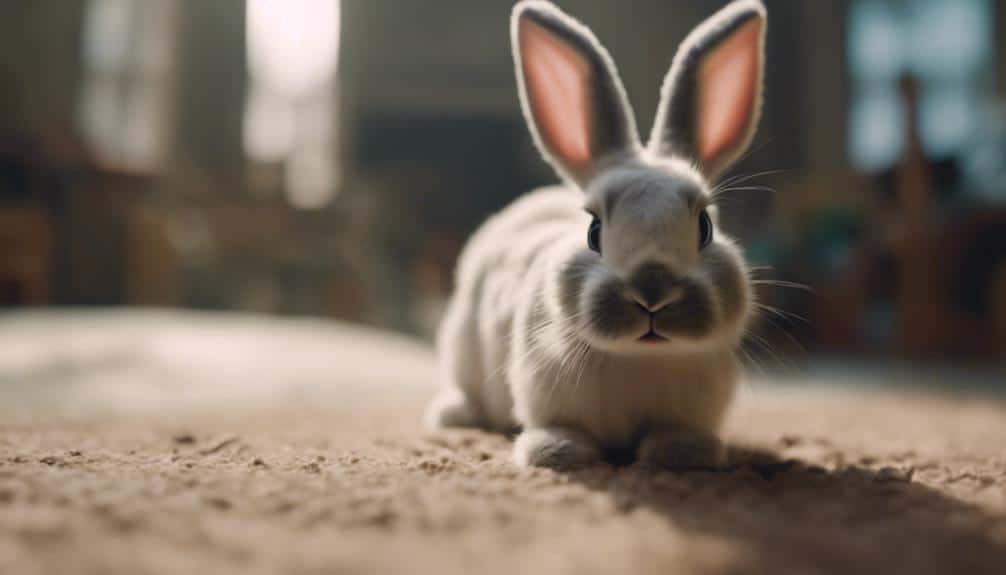
Bunnies use both their eyes and ears to get around and stay alert. With their big eyes on the sides of their heads, they can see a lot of what's going on around them. These eyes are great at picking up green and blue colors, which are common in the places where bunnies live. And because their eyes are on the sides, they can spot movements and possible dangers easily.
Not only do bunnies have sharp eyesight, but they also have excellent hearing. This means they can figure out where sounds are coming from, which helps them understand their environment even better. By combining what they see and hear, bunnies can keep watch and react quickly to any changes happening around them. This helps them stay safe and out of harm's way.
Knowing how rabbits see and hear gives us insight into how they experience the world. By understanding their visual and auditory needs, we can create environments that are safe and enjoyable for these sensitive animals. Taking care of their sight and hearing helps us take better care of them and improve their overall quality of life.
Bunny's Visual Care and Habitat Considerations
When setting up the bunny habitat, think about adding ledges strategically to give them more places to explore and exercise. Bunnies have a sharp sense of sight that helps them notice movement and understand their environment well. To make sure they're happy and healthy, it's important to consider their visual needs when designing their living space.
Bunnies are especially sensitive to colors like blue and green, so incorporating these hues into their habitat can make it more visually engaging for them. Lighting is crucial too, as bunnies have more rod cells than cone cells in their eyes. Providing natural-like lighting can help maintain their visual health.
Make sure that food and water are easy for bunnies to see in their habitat. Placing these essentials in accessible spots can help them find their way around more easily.
Frequently Asked Questions
What Does a Rabbits Vision Look Like?
Rabbits see the world differently than we do. They are really good at spotting predators, especially ones that are blue or green in color. This is because rabbits are more sensitive to these hues. Their eyes are designed in a way that helps them see far away objects clearly. This helps them adapt to their surroundings and stay safe in the wild.
How Do Rabbits View Humans?
When you go near rabbits, they see you in a special way. Their vision is a bit grainy but wide, so they can notice you easily. Rabbits identify you by your voice, how you move, and your smell. These visual cues help build a bond between humans and rabbits.
Do Rabbits See Color?
Rabbits don't see colors the same way we do. They can only see blue and green because of how their eyes are built. They can't see red or yellow well, so they're kinda color blind. Instead, rabbits pay more attention to things like movement and brightness in their vision.
How Do Bunnies Recognize You?
If you want bunnies to recognize you, just be consistent when you interact with them. Bunnies pay attention to how you look, your body language, the way you smell, and what they've experienced with you before to get to know you better. So, by reacting consistently to them, you can help them trust you and build a stronger connection with them.
Conclusion
Bunnies see the world in a unique way. They have a wide field of view, can see colors, and are good at seeing in low-light conditions. This helps them spot predators and move around safely.
Knowing how bunnies see can help you take better care of them and make their living space more interesting. Like a talented artist, bunnies use their sharp vision to create a vivid and detailed picture of their surroundings.


